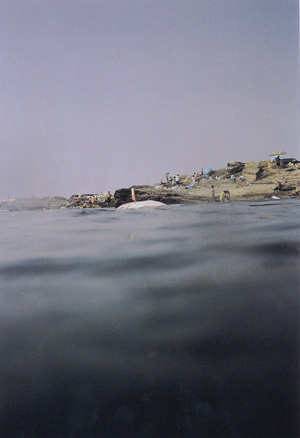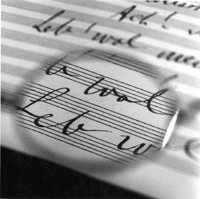
Asako Narahashi's view of the world is as an outsider. In her
photographs civilisation is a narrow band glimpsed on a thin horizon between
sea and sky. Taken while she is half submerged in the sea, these are awkward
snaps, with large parts of the image being oily seas and vacant skies.
The power of these images is their viewpoint. Seen as if through the periscope
of a submarine, or from the eye of a turtle as it swims to shore. It is
a view most bathers have experienced but few find natural. In very different
ways each of the eight young photographers in the exhibition 'Kiss in
the dark; Contemporary Japanese Photography presents an outsider's view
of the world.
The male body is the focus of Ryudai Takano. Takano confronts us with
life sized, full frontals of naked males. Well almost full Ð the naughty
bits are carefully cropped. Images are taken of the upper and lower body
with the dangly bit discretely out of the way. The halves are rejoined
in a nearly complete match but leaving a breezy slice through the crotch
Ð in part a response to the censorship rules as well as a comment on them.
And because he didn't want to waste the good bits, Takano has attached
them to the back of each photograph.
To stand in front of the huge colour images by Ryoko Suzuki is like witnessing
torture. They are extremely confrontational. Her series 'Bind' is of a
detailed image of her face tied tightly with a lace of pigskin, which
has been dipped, in blood.
It is difficult to look at these photographs of her contorted face even
though you now it probably didn't hurt much. However, the colour of the
pinched skin, the immaculate detail of the photographs, as well as their
enormous size Ð almost 2 meters square add intensity and power beyond
the subject.
Both Makiko Koei and Miyuki Ichikawa use photography in their work as
a means of painting images. Both use urban scenes, Koei crowds and Ichikawa
buildings, to create airy pastiches of city life - a sort of futurism
and impressionism transferred to photography.
Urban wastelands and derelict buildings are the subjects of Shinichiro
Kobayashi's work. In his majestic photographs he gives crumbling buildings
and disused factories the ethereal lighting and power of a Gothic cathedral.
The works in the exhibition are from a recent series ominously titled
Deathtopia.
The past is also the subject, of Tomoko Yoneda's images. Yoneda photographs
the texts of some of the 19th centuries-greatest writers and musicians,
through the lenses of their own eyeglasses. These works literally allow
us to 'see' through their eyes. The black and white image of 'Tanizaki's
glasses Ð viewing a letter to Matsuko' captures the circular rim of the
spectacles belonging to the art critic and authors, Tanizaki. The photograph
also give us a glimpse of the original kana text. Images of Mahler's last
symphony, No. 10 and Freud's view of a text by Jung, make illuminating
historical connections. However, it is the soft-focus images themselves
that are the most memorable and arresting aspect of Yoneda's work.
Watanabe Go's photographs of national and international borders resonate
in the present climate of world uncertainty. Ironically, his photographed
'border' Ð the bloody and disputed line between Bosnian and Herzegovinia
in Croatia, is the most romantically serene landscape of all of his photographed
borders. An idyllic scene of mountains, lake, green pastures and trees
belies the tragedy and hatred separated by a man-made division. In contrast,
his image of the border between the United States and Mexico is the most
fortified and bleak. A wall stretches out into the sea as the same waves
break on different national shores.
The works of these eight photographers in this fine exhibition at the
Museum of Photography reaffirm the importance of this medium to contemporary
culture. As a tool of reflection there may be none more powerful than
the image presented by the contemporary photographer. This exhibition
is a good opportunity to take a good look at ourselves.


/Dreamweaver%203/Sites/pnaumann/ruin.jpg)

